The Decision Analysis Process
Have you been faced with a high stakes business decision, fraught with uncertainty? How did you take on the problem? Looking back were you certain there was no value left on the table?
Start ensuring you’re making the most well informed decisions for your business by applying the Decision Analytic process, thereby ensuring you have:
- Accounted for Risks
- Quantified Uncertainty
- Valued Critical Outcomes
Take a walk through the Decision Analytic process with Acme Corporation, a fictitious company faced with a very real new product development decision, employs decision analytic tools to reach a sound strategy. But perhaps most importantly, the process culminates in a deepened understanding of the venture, consensus among stakeholders, and the confidence to take action.
Start applying the Decision Analysis Process to your strategic decisions by requesting a FREE 21-day trial license of the DPL Professional software:
1. Acme Corp Faces a Difficult Decision
Stick with Barge or take a chance on Schooner

Schooner
New product in the later stages of development whose technology is better, faster, and cheaper than that of Barge
The Good: an early launch could capture market share from competitors
The Bad: on the flip side, early launch requires a large capital investment

Barge
Reliable, legacy product who shares market with a few companies that employ the same, aged technology
The Good: Barge's technology is tried and true; profits are reliable
The Bad: market experts predict Barge's technology may soon be obsolete
2. Analysis Team Frames the Problem
Using DA tools an initial decision frame is established
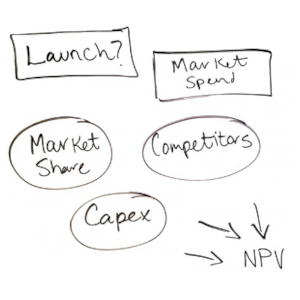
Whiteboard of the Decision Frame
Decisions:
- Should we Launch Schooner?
- How much should we spend on Marketing?
Uncertainties:
- How much share of the market will we capture?
- How many direct competitors will we have?
- How much will we spend on Capex?
3. Decision Makers Modify Decision Frame
Decisions, Alternatives, and Uncertain variables are added
Proposed modifications:
- waiting and observing the competition is an available decision alternative
- pricing (Premium or Aggressive) is a decision, not an uncertainty
- product quality is uncertain and may affect Market Share early on
After management review, the updated decision frame looks like:
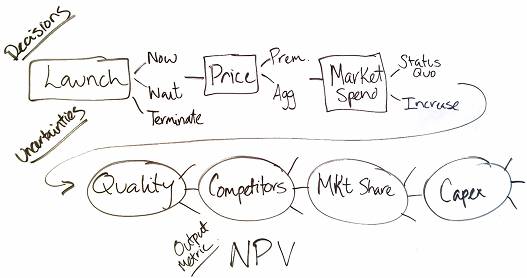
Modified Whiteboard of the Decision Frame
Decisions:
- Launch Schooner
(launch, wait, kill) - Marketing Spend
(status quo, increase) - Pricing
(premium, aggressive)
Uncertainties:
- Quality Issues
(none, minor, widespread) - Market Share
(low, nominal, high) - Competitors
(none, one, several) - Capex
(low, nominal, high)
4. The analysis team builds a quantitative model in DPL
DPL’s intuitive decision modeling interface is employed
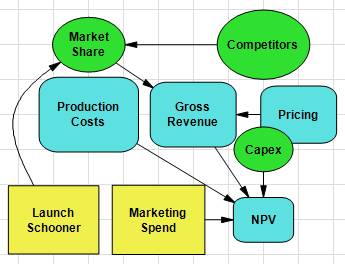
Influence Diagram
The Influence Diagram depicts the main factors in the decision and the relationships between them via arcs.

Decision Tree
The Decision Tree graphically depicts the decision structure and specifies the timing of events.
5. Expert interviews provide data inputs for the model
Conditional relationships are defined in the Influence Diagram

Conditional Relationships
Add arcs between the nodes
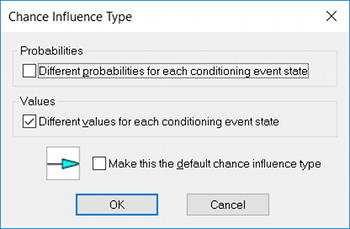
Change Arc Type
Specify arc conditioning type. Options are probabilistic, value-wise, or both.
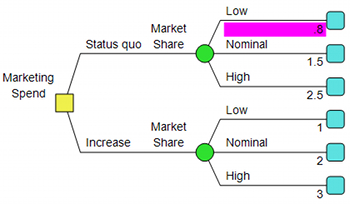
Node Data Input Tree
Edit the conditioned node’s data input tree.
6. A Preliminary Analysis of the Model is Run
DPL’s Policy Tree Output Serves as a Strategic Roadmap
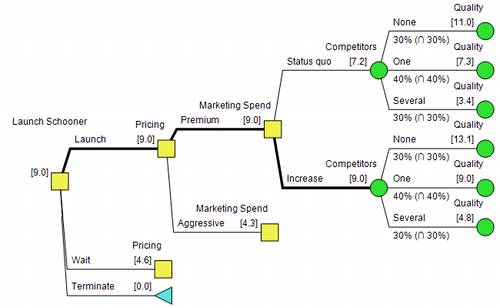
Policy Tree
The Policy Tree output indicates that the best strategy is to launch now with premium pricing and increased marketing spend. However, that strategy does poorly in scenarios where there are several competitors.
7. Initial Results Motivate New Strategies
A Downstream Pricing Decision is Added to the Model
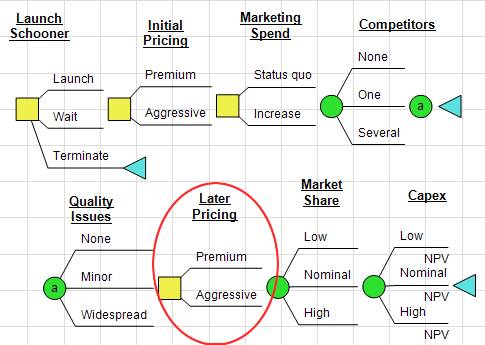
Downstream Decision
In response to results, they decide premium pricing doesn’t make sense in the face of strong competition. The model is modified to include two phases: Initial Pricing and Later Pricing. The Later Pricing decision is made after they observe Competitors and Quality.
8. DPL Outputs Point to a Clear, Winning Strategy
The Analysis Team and Decision Makers are all On-board
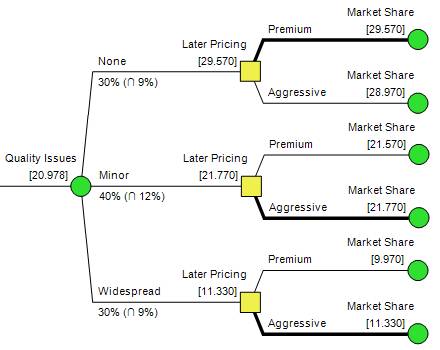
Scenarios in the Policy Tree
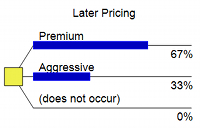
Policy Summary
DPL’s Policy Summary how often (% of scenarios) Aggressive pricing is the optimal alternative.
9. Acme Takes Action with Confidence
Acme launches the New Product, Schooner, backed by a clear, confident plan

The decision analytic process proved to deepen the understanding of the problem at hand which served to build consensus among the all the parties involved and build confidence in the strategic direction the organization has taken.